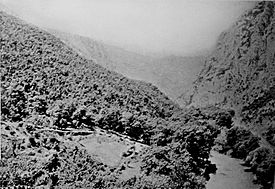Battle of Tempe Gorge facts for kids
Quick facts for kids Battle of Tempe Gorge |
|||||||
|---|---|---|---|---|---|---|---|
| Part of the Balkans campaign during World War II | |||||||
 Tempe Gorge c. 1941 |
|||||||
|
|||||||
| Belligerents | |||||||
| Commanders and leaders | |||||||
| Units involved | |||||||
| Australian 16th Brigade New Zealand 21st Battalion |
2nd Panzer Division 6th Mountain Division |
||||||
| Strength | |||||||
| 1 brigade | 1-2 divisions (elements) | ||||||
| Casualties and losses | |||||||
|
Australian: 4 killed or wounded |
140 killed or wounded | ||||||
The Battle of Tempe Gorge, also called the Battle of Pinios Gorge, happened on April 18, 1941. It was a fight during World War II in Greece. Soldiers from Australia and New Zealand, called "Anzac Force," tried to slow down the German army. They fought hard all day in a narrow valley called Tempe Gorge. Even though the Anzacs had many losses, their brave stand helped other Allied soldiers escape safely. This allowed the Allies to set up a new defence line further south.
Contents
Why was the Battle of Tempe Gorge Important?
As German forces moved through central Greece, Allied soldiers were retreating south. They needed to slow down the Germans. Tempe Gorge was a perfect place to do this. It was a narrow valley, easy to defend.
Who Fought at Tempe Gorge?
The group chosen to defend the gorge was called "Anzac Force." It included two Australian battalions: the 2/2nd and 2/3rd Battalions. They were part of the Australian 16th Brigade. New Zealand soldiers also joined them. These included the 21st Battalion and some artillery units.
Many of these soldiers had fought before in Libya. They were then quickly sent to Greece to help. Brigadier Arthur Samuel Allen led the Anzac Force. The Australian soldiers had mortars and small arms. The New Zealanders had artillery guns, but not much ammunition. Their anti-tank rifles were not very effective.
What Happened During the Battle?
On April 18, the German 6th Mountain Division attacked. They were led by General Ferdinand Schörner. The Germans wanted to reach Larissa quickly. This would cut off the main Allied retreat path. Brigadier Allen's goal was to hold the gorge. This would protect the main Allied force as they pulled back.
How Were the Forces Positioned?
The Anzac soldiers spread out along the river. Their lines were thin, with about 1,000 yards between companies. The Australian 2/2nd Battalion was in the middle. This was the most important spot. They faced the German attack from Gonnoi. The New Zealand 21st Battalion was on the right. They destroyed a bridge to stop the Germans. Two companies from the Australian 2/3rd Battalion were on the left.
The German Attack Begins
The battle started just after 7:00 AM. The Germans attacked the 2/2nd Battalion first. Later, around noon, German units led by Lieutenant-Colonel Hermann Balck attacked the New Zealand 21st Battalion. The 21st Battalion had already faced Balck's units before.
The New Zealand 21st Battalion struggled against the German attack. They were almost completely surrounded and had to retreat into the hills. German tanks then crossed the Pinios River. This river was supposed to be guarded by the 21st Battalion. This left only the 2/2nd Battalion to keep fighting. Some small vehicles tried to push back the Germans. But they failed and were lost. Mortars were used, even overloaded, to reach the German troops. By 5:30 PM, the battle became very chaotic. The 2/2nd Battalion broke apart under the strong German attacks.
What Was the Result of the Battle?
By 6:45 PM, orders were given for the Anzac soldiers to withdraw. The Anzac forces had suffered many losses. But they had held their ground for a whole day. This allowed the main Allied forces to escape through Larissa. The Australians and New Zealanders moved through the night. They fought more small battles as they retreated. By dawn on April 19, they were in a new defence position near Thermopylae.
The Australian 16th Brigade had about 80 soldiers killed or wounded. Around 120 were captured. The New Zealand 21st Battalion lost four soldiers killed or wounded. German losses were about 140 killed or wounded. After the battle, the Australian 2/2nd Battalion was badly damaged. It did not fight as a full unit again until after the fighting in Greece ended.

